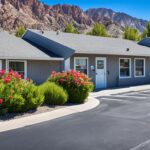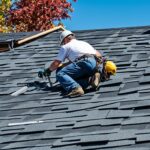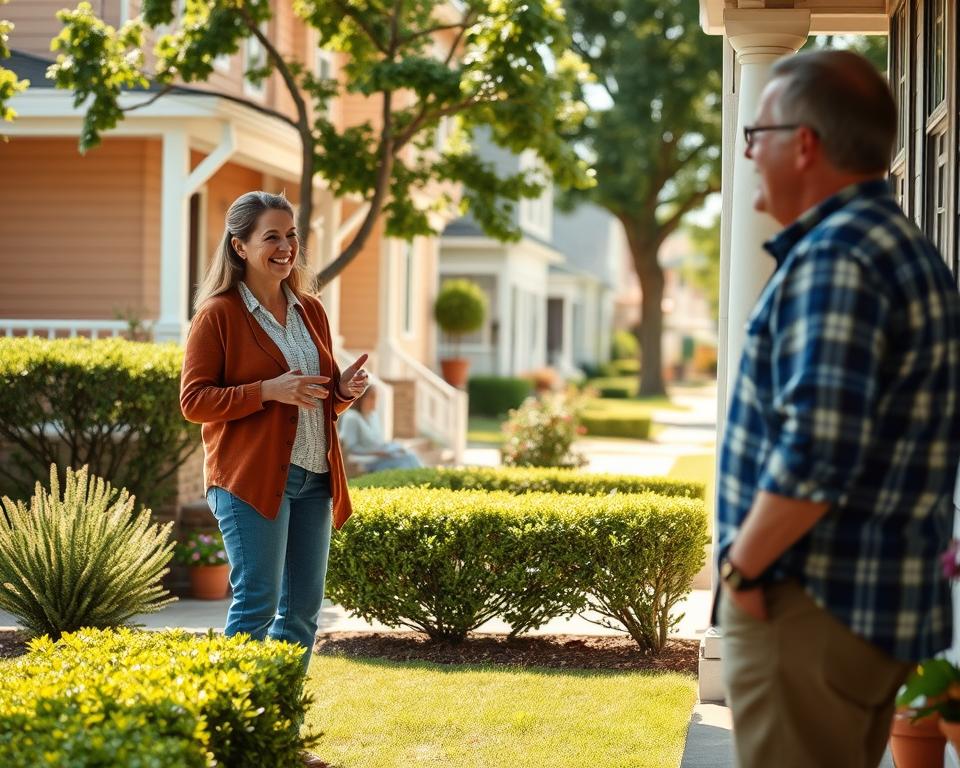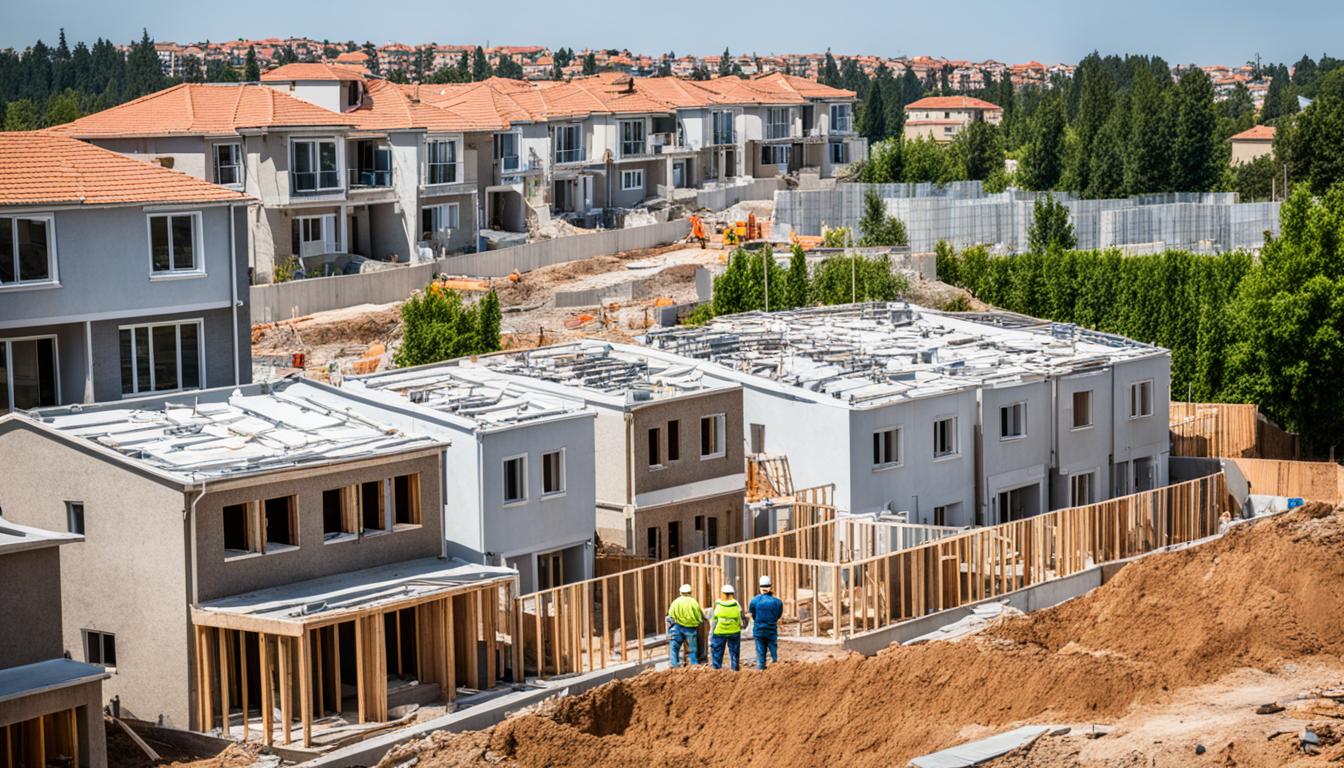The idea of neighborhood and built environment greatly affects how people live. Sustainable neighborhoods show what good urban planning looks like. They make sure the environment and community health goals work together.
Healthy People 2020 aims to make living areas safer and healthier. But, living in dangerous or polluted places can harm your health. This is especially true for racial/ethnic minorities and those with low incomes. Yet, making places more pedestrian-friendly and adding green spaces can really help.
Healthcare groups are now supporting affordable housing projects. They work to keep and grow affordable homes for those who need them most. Communities can use a Housing First approach to improve living conditions. Governments can also help by supporting quality, affordable rentals through special plans.
Key Takeaways
- Sustainable neighborhoods are key for community health and happiness.
- Healthy People 2020 highlights the need for safer, healthier living areas.
- Green spaces and pedestrian-friendly areas can make neighborhoods better.
- There are efforts to keep and increase affordable homes for those who need them.
- State governments can help by supporting affordable rental housing.
Introduction to Community Design and Its Importance
Community design blends architecture, transportation, public spaces, and planning to boost health. It makes neighborhoods safer, more active, and connected. It’s key to think about how spaces affect people’s minds and needs.
The Basics of Community Design
Community design focuses on making spaces easy to get around and encouraging people to move more. The Prevention Institute found that safe paths and fresh food lead to more exercise and better eating. This mix of city planning and nature can greatly reduce health gaps in areas.
Why Community Design Matters for Health and Well-Being
Designing communities well can really help people’s health. A report by Manal J. Aboelata, MPH, shows how the environment affects health. Bad neighborhoods often have high crime, little greenery, and few fresh food spots, leading to health issues like obesity and asthma.
By 2050, more people will live in cities, making good planning crucial. Good planning helps people stay active and mentally well, making life better for older folks. As cities expand, working together on health and planning will tackle issues like inactivity and mental health.
Health Impacts of Built Environment
The built environment deeply affects our physical, mental, and social health. It plays a key role in our daily lives. By understanding this, we can work to reduce health gaps and make society healthier.
Physical Health
Our neighborhoods’ design and resources greatly impact our physical health. Between 1988-1994 and 1999-2000, more Americans and children became overweight or obese. Now, 64.5% of adults over 20 are overweight, and 30.5% are obese.
These environments also shape how much physical activity we do. For example, single-lane roads are linked to more diabetes and obesity. On the other hand, non-single-family homes have less obesity, diabetes, and inactivity.
Green spaces are vital for physical activity and fighting chronic diseases like obesity and high blood pressure. These diseases are big factors in stroke deaths in the U.S.
Mental Health
Our mental health is deeply affected by our surroundings. Green areas are linked to less mental stress and less binge drinking. Adding more green spaces in cities can lower stress and mental health issues.
For instance, the Atlanta Olympic Games saw a 41.6% drop in asthma emergencies, showing how clean air helps mental and physical health. But, poor environmental conditions, like in parts of the South Bronx, can lead to much higher asthma rates, affecting mental and physical health.
Social Well-Being
How our communities are designed is key to community engagement and social well-being. Neighborhoods that encourage people to interact can build strong community ties and reduce isolation. Green spaces in these areas also lower violence, showing the big impact of good design.
Poor living conditions and infrastructure can make it hard for communities to come together and lead unhealthy lives. Safe, easy-to-get-to neighborhoods boost physical activity and social interaction. These are crucial for mental health and community unity. Together, they help create communities where people are healthier and happier.
In conclusion, the built environment greatly affects our lives, from physical activity to community engagement. Well-designed spaces can lower health risks and improve life quality for everyone. By focusing on healthy living and community ties, we can make neighborhoods that support everyone’s well-being.
Community Design and Physical Activity
Creating communities that support physical activity is key to an exercise-friendly society. The design of a community can really push people to walk, cycle, and exercise more. Sadly, only about 1 in 4 adults and 1 in 6 high school students meet the activity guidelines set by the Physical Activity Guidelines for Americans. This shows we need better community designs and policies to help people live more actively.
The Role of Walkability
Walkability is crucial for getting people to move more. Research in New York City by Freeman and colleagues showed that walkable areas make it easier to walk and cycle. With good street designs, sidewalks, and paths, people can safely move around, making walking a better choice for getting around.
In places where minorities or people from rural areas live, finding safe places to exercise is hard. Making policies to improve paths for walking, biking, or public transport can really help increase exercise in these areas.
Biking Infrastructure
Building good biking paths is also important for an active society. Studies have shown that new cycling routes get more people moving. Goodman et al. (2014) found that better biking paths and lanes make cycling a popular choice for staying active.
Biking infrastructure should include safe bike lanes, parking, and links to public transport. Adding these to community designs helps make sure everyone has a way to stay active and use sustainable transport.
Effects of Design on Safety and Injury Prevention
Designing neighborhoods with safety in mind greatly affects crime prevention and public safety. By using strategic urban planning, we can make places that boost physical activity and lower injury and crime rates.
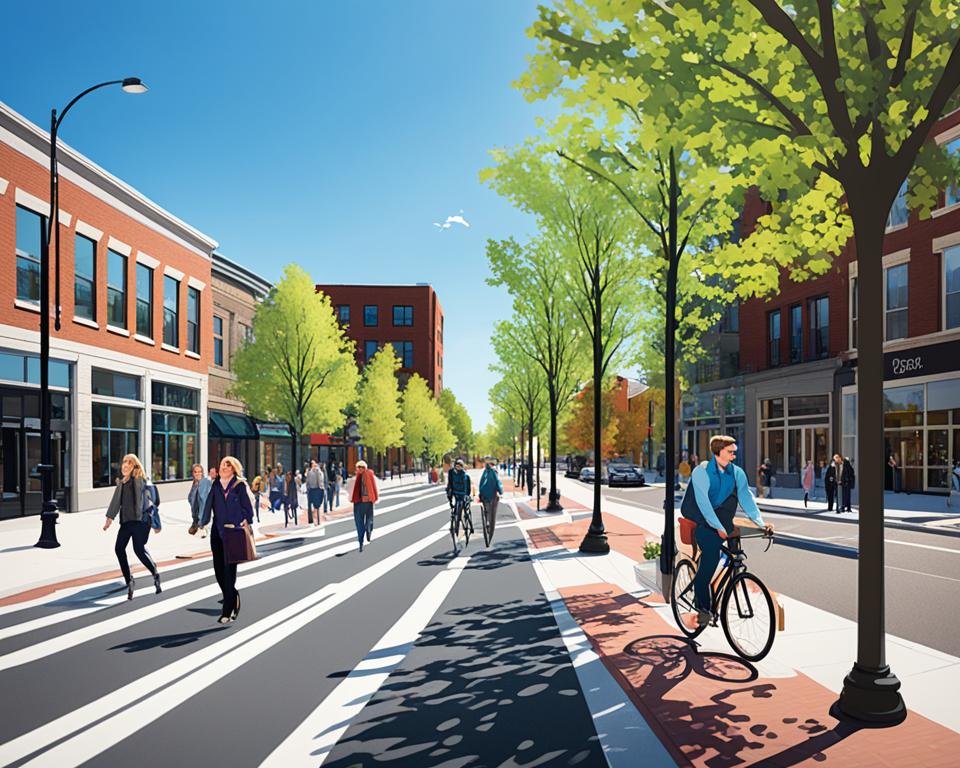
Reducing Crime Through Environmental Design
Environmental design is key in cutting down crime rates. Things like well-lit streets, open areas, and busy sidewalks can keep criminals away. The City of New York’s Active Design Guidelines (ADG) from 2010 offers 18 urban and 9 building design tips for safety.
These guidelines show that 14 out of 18 urban and 7 out of 9 building strategies help prevent injuries. With traffic being a top cause of death for Americans under 44, it’s vital to have traffic calming measures. Studies prove that these measures can prevent injuries and help keep communities safe.
Safety in Mixed-Income Neighborhoods
Mixed-income neighborhoods greatly affect public safety and social unity. Making these areas more walkable and having sidewalks can encourage people to move more and lower injury risks. In rural areas of northwestern North Carolina, it was found that sidewalks are not always available, showing the need for consistent sidewalk installation for better safety.
Falls from heights, like from windows or balconies, are a big concern, especially for kids. Building designs with safety features can help prevent these accidents. Also, making places that support walking to public transit can help people meet exercise goals and reduce injury risks. Revitalizing mixed-income areas can make them safer and more lively.
At the end, designing our environments thoughtfully is crucial for improving safety, health, and community life.
Environmental Factors in Neighborhood Design
Looking at environmental factors like air and water quality is key to healthy living. These factors greatly impact people’s health. Good neighborhood design can make a big difference, helping the community stay healthy.
Air Quality
Air quality is crucial for a healthy life. Research shows that the way a neighborhood is designed affects air quality. For example, where homes, schools, and factories are placed can make asthma worse or better.
Improving buildings with better materials and air flow helps people breathe easier. Adding green spaces also cuts down pollution. This helps fight climate change by reducing harmful gases.
Water Quality
Water quality is vital for a sustainable community. Clean water stops many health problems, from stomach issues to reproductive issues. Good city planning means having modern systems for treating and giving out water safely.
Less pollution helps keep water clean. This can be done by reducing industrial waste and using natural ways to filter water. Clean water is good for people’s health and makes neighborhoods healthier places to live.
Transportation and Design Choices
How we move around affects our connection to our community. Good public transit cuts down on car use, easing traffic and pollution. It also encourages people to walk or bike, boosting health.
Public Transportation
Choosing sustainable transport helps make cities move better and cleaner. Making public transit easy to use means people can get around without cars. Studies show we spend about an hour a day in traffic, showing the need for good public transport.
Transport services are now listening to what people want, making them more popular. This helps people use public transport more and own fewer cars.
Reducing Automobile Dependency
Less car use means less traffic and a healthier city. Research shows how travel time and the area’s design affect how we choose to travel. Designing neighborhoods for walking, biking, and public transport encourages people to be active.
Using the 5Ds framework helps cities create places where people use less cars. This leads to more walking, biking, and public transport use, making cities better for everyone.
| Benefits | Statistics |
|---|---|
| Reduction in Traffic Congestion | 25% decrease in high-density areas |
| Environmental Impact | 30% reduction in CO2 emissions |
| Physical Activity Increase | 32% more active residents |
| Economic Savings | $1,200 saved annually per household |
Designing cities with these ideas in mind helps reduce car use. It makes transport sustainable and improves access to public transit. By making smart choices, cities can make life better for everyone.
Zoning and Neighborhood Character
Zoning is key to land use policy. It decides how areas in a community are used and developed. By setting community zoning laws, it balances current needs with future growth. Zoning can fit a community’s unique needs, covering residential, commercial, industrial, and mixed-use areas. These rules shape neighborhoods’ look and function.
Types of Zoning
Every community has its own zoning code to control building and development. These codes can be simple or complex, covering zones like residential, commercial, industrial, and more. For example, historic districts might have strict rules on building styles to keep their look.
- Residential: Areas just for homes. These rules can set limits on building height and size.
- Commercial: Zones for businesses, including shops, offices, and services.
- Industrial: Places for factories, warehouses, and other industrial work.
- Mixed-Use: Combines homes, businesses, and sometimes civic spaces for a community feel.
Zoning also sets rules on building height, lot sizes, and how close buildings can be. It can allow special exceptions for projects that help the community, like creating jobs or affordable homes. Zoning is key to urban growth, keeping life quality high and supporting sustainable development.
Mixed-Use Developments
Mixed-use developments are a smart way to use land. They mix homes, shops, and civic spaces to boost community life. This design encourages walking and reduces car use, making neighborhoods more vibrant.
For instance, a project with homes and shops below can keep the area lively and connected. Mixed-use projects are great for urban growth, making neighborhoods better places to live and visit.
| Type | Primary Use | Examples of Regulations |
|---|---|---|
| Residential | Housing | Density, building height, lot size |
| Commercial | Businesses | Setbacks, space between buildings |
| Industrial | Manufacturing | Buffer zones, noise limitations |
| Mixed-Use | Varied (residential, commercial) | Flexible rules for mixed use |
Whether through single-use or mixed-use zoning, community zoning laws are vital in planning cities. By updating these laws, communities can grow in ways that keep their character and meet residents’ needs.
Benefits of Mixed-Use Communities
Mixed-use communities are gaining popularity in the U.S. and globally. They offer many benefits, from economic gains to better social life. These communities are changing how we live in cities.
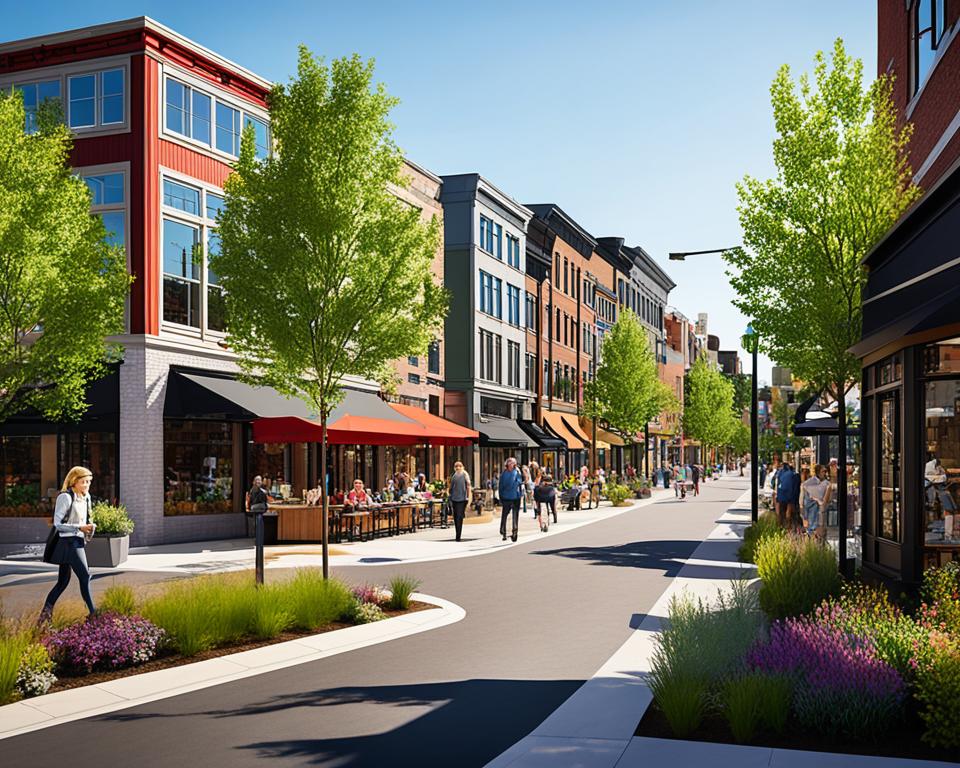
Economic Advantages
Mixed-use planning boosts urban economics in big ways. It combines homes, shops, and sometimes workspaces in one spot. This saves money on building and running things. Plus, it gives developers different ways to make money, making their businesses more stable.
Social Interaction and Cohesion
Mixed-use areas are great for bringing people together. Living near work, stores, and restaurants means more chances to meet others. This closeness builds a strong community feeling and sense of belonging.
These areas also mean less driving, which helps reduce traffic and is better for the planet. People walk or bike more, making neighborhoods lively and connected.
Neighborhood Design for Accessibility
Designing neighborhoods with accessibility in mind helps people with disabilities join in community activities. It’s important to make spaces welcoming for everyone. This means thinking about the needs of disabled residents and removing barriers.
Design Considerations for Disabilities
Using universal design principles makes neighborhoods accessible to all. This includes ramps, facilities that can be used by everyone, and easy-to-follow layouts. Ramps and wheelchair-accessible paths are key to ADA-compliant infrastructure. They help prevent accidents, especially for wheelchair users who face a higher risk.
Creating inclusive design neighborhoods boosts walkability and wheelchair access. This supports people with disabilities and encourages healthier living. For example, easy access to stores and pharmacies makes seniors more independent. Busy main streets with more pedestrians also make traffic slower and support local businesses.
Universal design also highlights the value of green spaces. These areas, connected by paths, let people with disabilities enjoy nature and its health benefits. Adding street trees and greenery improves life quality in neighborhoods.
The James Driver All Inclusive Park in Harris County, TX, opened in December 2021. It has wheelchair-friendly equipment and accessible play areas. Similar efforts in Clarksville, TN, show how signs and virtual maps on the Cultural Trail help everyone navigate better.
Local leaders should work with residents to check how accessible and inclusive public spaces are. By looking at social impact regularly, they can make sure public areas suit everyone’s needs. This helps create places where everyone can do well.
Role of Policy and Interventions
Government policy is key in making neighborhoods better and safer. It affects public health and community safety. At all levels, from local to federal, policies help with urban renewal and health initiatives. By using laws and plans, governments can make neighborhoods healthier and safer.
Local and State Policies
Local and state policies drive urban renewal. They create places that encourage people to be active and social. For example, the Community Preventive Services Task Force gives advice on how to make places more active. Cities also spend on parks and public areas to boost community health.
In rural areas, policies on food and the environment help fight obesity, as shown by a study from 2002 to 2013. These efforts are key for better health and sustainable communities.
Federal Interventions
Federal actions are also vital in shaping neighborhoods. Programs like Healthy People 2030 aim to make neighborhoods healthier and safer. The Neighborhood and Built Environment framework suggests big changes for better health. The STRETCH (Strategies to Repair Equity and Transform Community Health) by the CDC Foundation and Robert Wood Johnson Foundation focuses on fairness in health efforts. It offers a full plan to tackle health gaps.
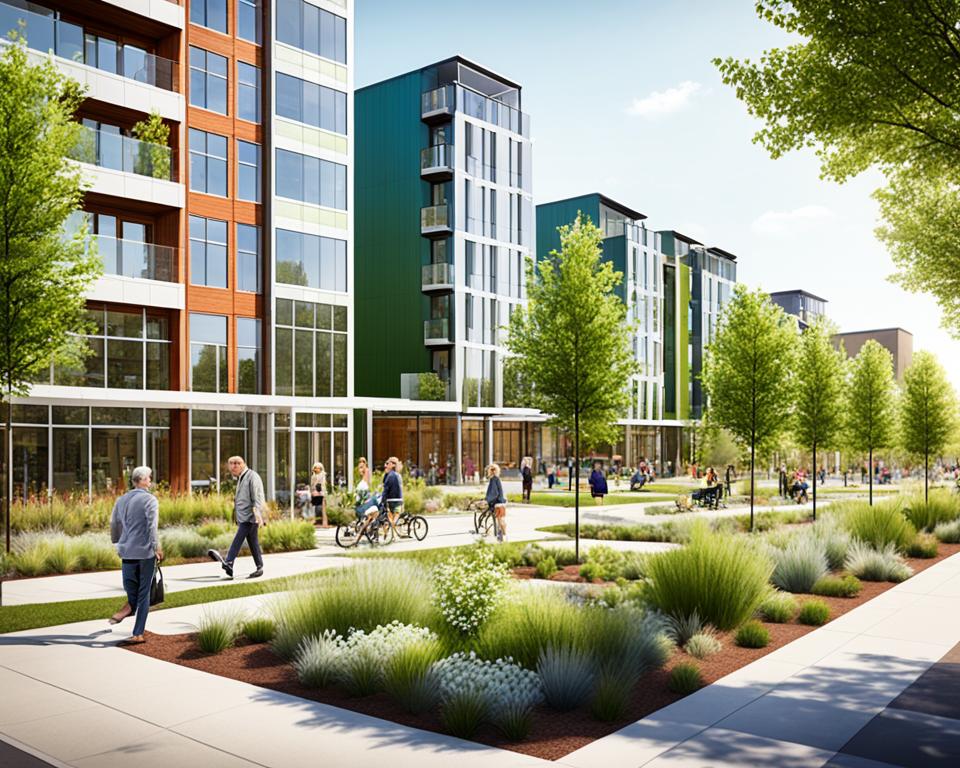
| Intervention | Impact | Source |
|---|---|---|
| Creation of Parks | Improves physical activity and mental well-being | Community Preventive Services Task Force |
| Nutrition-related Policies | Reduces obesity rates in rural communities | Calancie et al., 2002-2013 |
| Healthy People 2030 | Promotes health and safety in neighborhoods | Healthy People 2030 initiative |
| STRETCH Framework | Addresses health disparities | CDC Foundation, 2022 |
Neighborhood and Built Environment: Success Stories
Looking at different places in the U.S., we see how good design can change neighborhoods for the better. These stories show how working together, making smart choices, and supporting policies can make a big difference. They improve health, safety, and life quality in communities.
Case Studies in the United States
In Vermont, a project helped small towns make better public areas and places for outdoor fun. This was to stop bad experiences in childhood and make health better for everyone. In Tennessee, grants went to improve areas with green spaces, playgrounds, and places for people to meet.
Health groups are now using design to stop bad experiences in kids and make communities safer. Studies show that good design can really help communities feel better.
Revitalized Communities
College students took photos to share stories of improving neighborhoods. A study with 37 students found that parks and paths near homes and schools help people move more. These places make people feel better and bring communities closer together.
In Colorado, a program gave money for small projects that get people moving and using public transport. Working with state agencies and local groups, these projects show how good planning can cut down on diseases and make communities healthier.
| State | Initiatives | Outcomes |
|---|---|---|
| Vermont | Technical Assistance Pilot | Development of public spaces, health equity promotion |
| Tennessee | Office of Primary Prevention Grants | Enhanced access to green spaces, fostered social connections |
| Colorado | Built Environment Program | Promotion of physical activity, chronic disease reduction |
From small towns to big cities, these examples show how the right mix of policy, design, and community effort can change a place for the better. Stories from different places prove that good planning and improving neighborhoods can make a big difference in health and happiness. These stories show that smart investments in our surroundings can have a lasting impact on our well-being.
Challenges and Future Directions in Community Design
Community design faces big challenges that slow its progress. These include political, economic, and psychological barriers. To overcome these, we must work together for better urban sustainability. It’s key to understand these obstacles to improve public health through design.
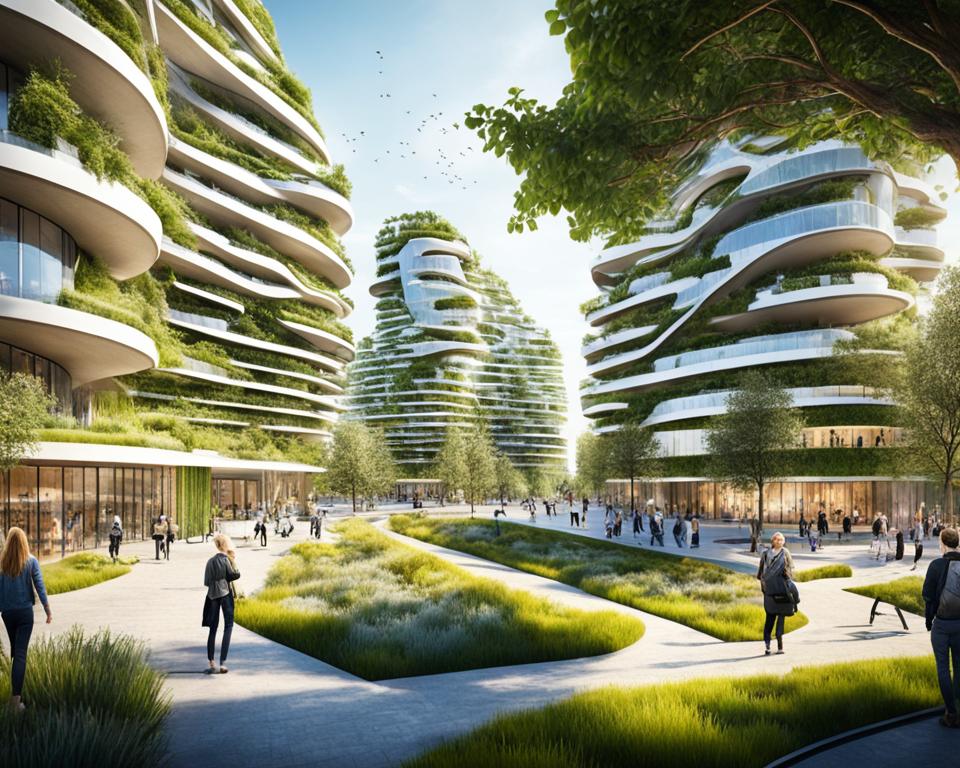
Barriers to Effective Design
Poverty is a big challenge in city planning. It affects how active people are and their health, especially in poor areas. Studies show that living in poverty can make people less active and more depressed.
Money issues also lead to different cancer rates in different groups. For example, some Jewish neighborhoods in New York have more thyroid cancer. In California, breast cancer rates vary by race and money status, making things worse for some groups.
Where people live affects their health too. In California, breast cancer is diagnosed at different stages in White and Black women, which changes survival chances. Liver cancer rates in Hispanics and Asians in California also depend on where they’re from and how American they feel.
Designing communities must think about things that stop people from being active after cancer. For example, some cancer survivors feel they can’t be active because of their surroundings. Also, when neighborhoods go through foreclosures, it can make breast cancer survivors feel worse about their health. We need to help these people more.
Research Needs and Emerging Trends
We need more research to tackle community design challenges. It’s important to look at how race and money affect design. We should study how where people live and segregation impact health, like breast cancer diagnosis in California.
New trends suggest using green spaces, building smart cities, and being sensitive to culture in urban planning. These ideas aim to meet the needs of diverse communities and protect the environment. For instance, projects in low-income areas have shown how better environments can improve health.
In conclusion, solving community design challenges requires looking at many factors. We must keep researching and following new trends to make cities better for everyone.
Conclusion
Our deep dive into community design shows how the layout and structure of neighborhoods affect people’s health. We’ve seen how walkability, mixed-use developments, and easy access to amenities boost both physical and mental health. For example, innovative health models led to a 22% drop in emergency room visits and hospital stays.
Also, reducing the number of places that sell alcohol cut down on heavy drinking by 28%. This shows how important it is to plan communities with health in mind.
Looking ahead, we should focus on research, new policies, and working together to meet the needs of all people. We need to act on the link between more alcohol outlets and more domestic violence. Food insecurity is a big issue in places like Hyde Park, affecting 65% of people there. We need smart planning and policies to build healthy, sustainable cities.
Learning about poverty through simulations has shown us a lot, with 80% of people taking part. This highlights the need for education to understand health issues. We also see big differences in getting to trauma care, and fixing this is key. To make cities better for everyone, we need everyone to work together.
For more on how neighborhoods affect teens’ weight, check out the study from Oslo. The study in Shiraz, Iran, also shows how the area people live in affects their health.
Source Links
- Welcome to the MDHHS State Innovation Model
- Community Design Resources
- Neighborhood and Built Environment – Federal Policy to Advance Racial, Ethnic, and Tribal Health Equity
- ENV_BuiltEnvProfiles_web_020305.qxd
- Chapter 5. Urban Form and Neighborhood Design
- Impact of the Built Environment and the Neighborhood in Promoting the Physical Activity and the Healthy Aging in Older People: An Umbrella Review
- The Built Environment and Its Relationship to the Public’s Health: The Legal Framework
- Health and the built environment in United States cities: measuring associations using Google Street View-derived indicators of the built environment – BMC Public Health
- Built Environment
- Strategies for Physical Activity Through Community Design
- Physical Activity: Built Environment Approaches
- The Impact of Community Design and Land-Use Choices on Public Health: A Scientific Research Agenda
- Building safety into active living initiatives
- Changing the Built Environment to Prevent Injury
- Building safety into active living initiatives
- Effects of neighborhood built environment on cognitive function in older adults: a systematic review – BMC Geriatrics
- Linking social and built environmental factors to the health of public housing residents: a focus group study – BMC Public Health
- Travel and the Built Environment
- Design & the Built Environment – African American Design Nexus
- How Built Environments Affect Health | Elevance Health
- Chapter 26. Changing the Physical and Social Environment | Section 13. Enhancing the Built Environment through Design | Main Section
- The Case Against “Neighborhood Character”
- What Does Community Character Mean Anyway? – Americas: ULI Boston
- The benefits and drawbacks of mixed-use development | The Korte Company
- Mixed Use Development Benefits | Chris Falk | Utah
- What is a Mixed-Use Neighborhood? – Blue Zones
- Universal Design: Neighborhoods | asla.org
- Using Universal Design to Create Safe, Welcoming and Joyful Spaces
- Policy, Systems, and Environmental Change – Rural Health Promotion and Disease Prevention Toolkit
- Neighborhood & Built Environment | Social Impact
- Neighborhood and Built Environment have major impact on health – Center for Population Health
- Improving the Built Environment Prevents ACEs and Creates Safer Communities
- Neighborhood Built and Social Environment Influences on Lifestyle Behaviors among College Students in a High-Density City: A Photovoice Study
- Built environment | Department of Public Health & Environment
- The Impact of Neighborhood Social and Built Environment Factors across the Cancer Continuum: Current Research, Methodologic Considerations, and Future Directions
- Community Design – ILG Planning Handbook
- ENV_BuiltEnvProfiles_web_020305.qxd
- Neighborhood and the Built Environment
- Neighborhood deprivation, built environment, and overweight in adolescents in the city of Oslo – BMC Public Health
- Human-built environment interactions: the relationship between subjective well-being and perceived neighborhood environment characteristics – Scientific Reports

